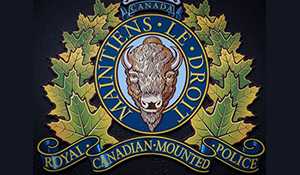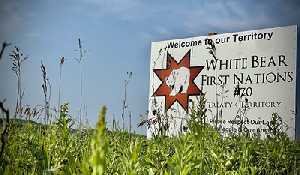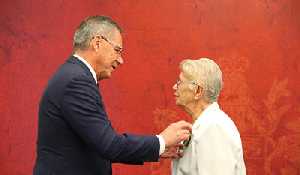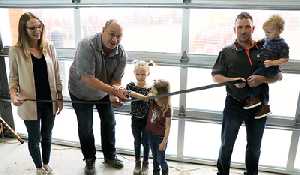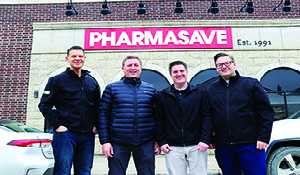Three local women volunteer in Tanzania, and deliver Little Dresses made by Wawota group
An opportunity to help in Africa
February 26, 2024, 10:55 am
Ashley Bochek
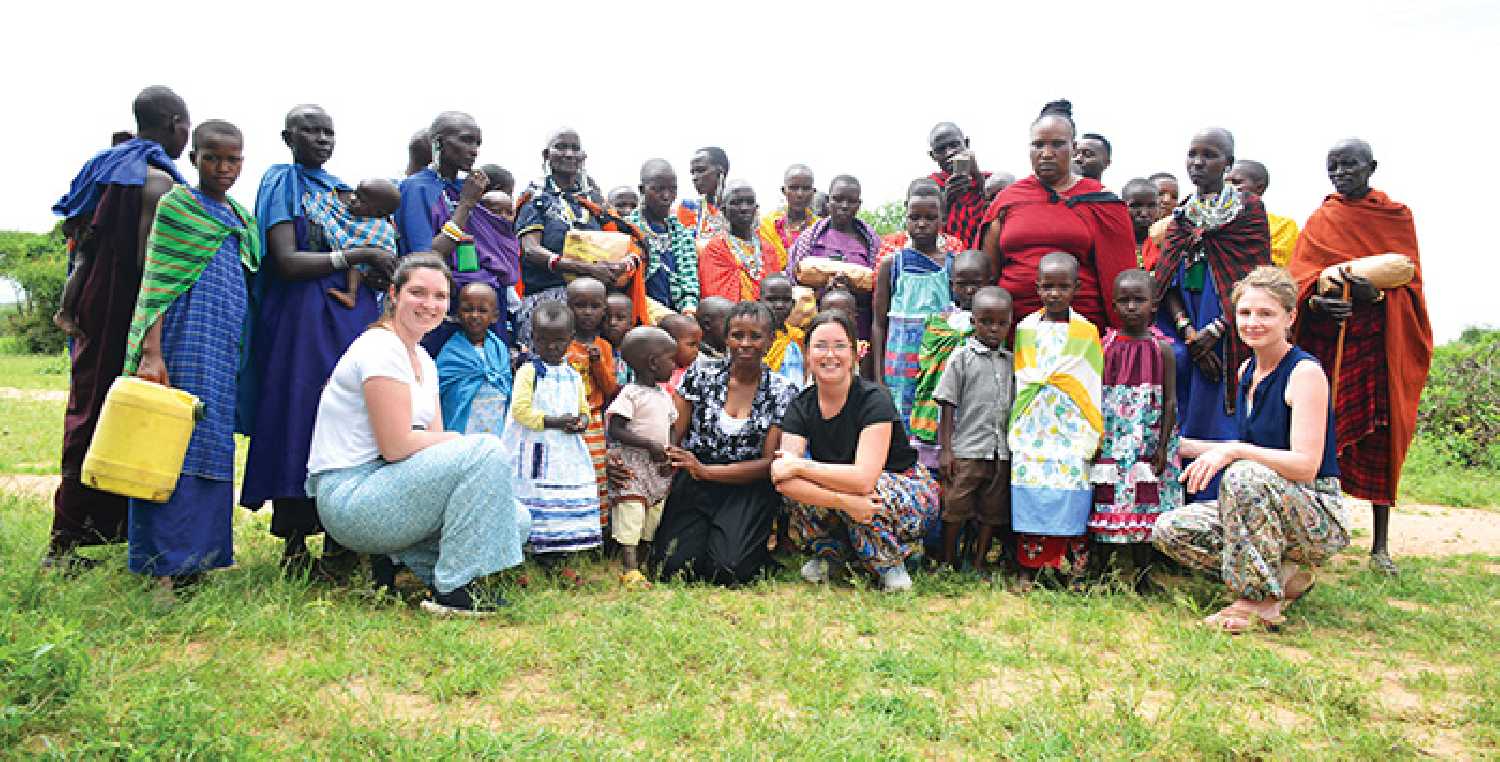

A desire to help took Trudi and Lynice Holmstrom and Keysha Horn of Moosomin to Arusha, Tanzania, in the shadow of Mount Kilimanjaro in east Africa, at the end of January. They helped children while volunteering at a daycare. They say the trip was memorable and they will forever cherish the memories, and the people they met.
“I knew everybody would ask us about our trip, but I don’t even know where to start—it is so different there than here,” said Trudi.
“In high school I had read a book called Live in Love and it is about Thomas Rhett and his wife’s journey toward adopting their daughter from Uganda, Africa. So, when I read this book I was like ‘I am going there—this is happening!’ That is kind of where it all stemmed from. It was my dream. Lots of people want to go to Africa to see the animals, but for me it was to see the kids,” Lynice says.
“Since high school she always wanted to visit Africa and see the kids and see the conditions they live in and what the environment looks like there,” adds Trudi.
“In the book it talks about their daughter being face down in the dirt at the orphanage, and so going there I knew the conditions were rough, but to experience it first hand is completely different,” says Lynice.
“Covid hit right when Lynice was out of high school, so she wasn’t able to go and it was a lot of paperwork because we were doing it as a volunteer experience. We needed a visa, a criminal record check, and an online program with the association we went with. The organization we booked it with was International Volunteer Headquarters (IVHQ) and they are based out of New Zealand, but they do volunteer programs all over the world. So, you can go anywhere they have arrangements to do volunteer work through them. They work with the local organization that houses volunteers in Tanzania which was called Tanzanian Host Experience. IVHQ partners with Tanzanian Host Experience, so they partner with a local organization and local people that help you once you get there. We went to Arusha, Tanzania. Arusha is the name of the city and Sakina is the area we were in.
“On the way we flew from Toronto to Detroit, and we got held up in Detroit with a storm and we missed our connecting flight in Amsterdam. So they automatically rebooked our flights and we flew to Qatar, which is east of Saudi Arabia.”
“We went all over Iran and Iraq right through the Middle East,” Lynice adds.
Trudi says, “So then we got to Qatar and looped around Saudi Arabia and went to Kilimanjaro.”
“The plane would go straight like it was heading to Qatar and then all of a sudden we’d be doing a sharp left and sharp rights then up again flying around countries,” Lynice explains.
Trudi adds, “we went right over the middle of the Black Sea. That was an adventure we didn’t really plan on, but we got there safe and sound. Then the Tanzanian Host Experience picked us up at the airport. With all that, Lynice’s luggage didn’t arrive, but Keisha and mine both did. She spent two days without it. It had missed the transfer at Amsterdam. So, it didn’t get transferred to our Qatar flight. That was a good thing with the Tanzanian Host Experience and IVHQ, we just told them what had happened and they took care of it for us.”
Lynice explains, “We stayed in what they call a Volunteer Home Stay, so they have four different houses throughout Arusha and they split volunteers between the four different houses. There were probably 25 other volunteers in our house, but there was about double that in the other ones.”
Trudi says they stayed in a compound in Arusha. “We say house, but where we stayed it was like a compound, so a common area and it had a dining room, living room, and kitchen, a separate area for a bunkhouse and office in a separate building all fenced in one area. We slept there, they fed us, they transported us, so it was like our accommodations and meals. They had people for the host company that would accompany us. They took us to get our SIM cards changed so we could get on their carrier so you can have data on your phones.”
Lynice adds, “At the beginning we were there for three days with no phones since we didn’t want to pay Saskatchewan prices in Africa.”
Lynice says they took excursions with the other volunteers, but did their volunteer work on their own. “Any excursions were together with the volunteers, but during the day our placement was different from others. Some of the other volunteers in our house were there for construction, child care, healthcare, women’s empowerment. There were four people that we stayed with who were building a home for a lady, and a school. The women’s empowerment people worked with women who have HIV or another condition and they would teach them how to make soap and sell it. They were trying to give them some skills that they can use to make some income.”
The Little Dresses Group of Wawota sent dresses and boys’ shorts with Trudi, Lynice, and Keisha to Africa to hand out to the children in need. “It was meant to be,” says Trudi. “I ended up talking to somebody and they had mentioned their hobby was sewing dresses for kids in third world countries. So, I asked ‘how do you get them there?’ and she said they just send them with people if they know someone is going. This happened on Wednesday and we were leaving that Friday. So they packed a suitcase and the Little Dresses Group has people who donate suitcases to them for this purpose. So, we just checked another bag and took the suitcase with us, not knowing how they would be distributed, but we thought we would just figure it out when we get there.”
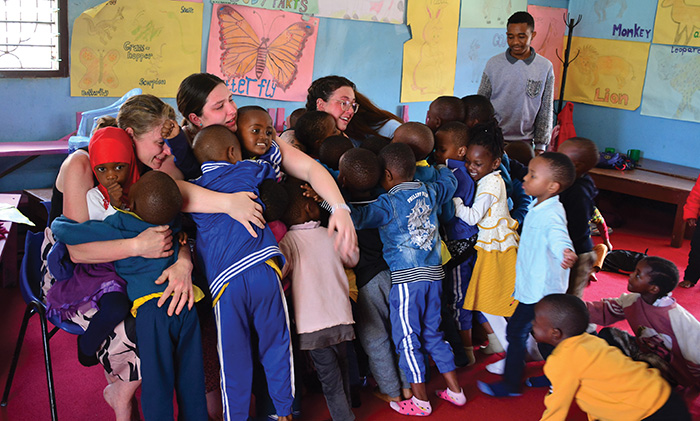

Lynice adds. “Just another adventure we thought we would take!
“In our placement we were in a daycare for one week with kids from under two to five years old. They’re divided up by age in these classrooms and all of them are very needy. Needy as in they could all use something—food, clothes, education.
“They have very little for personal possessions. The daycare was well staffed and a good building and good playground equipment, but it was almost run more as a school than a daycare. The kids were put in a room with kids of similar age and a teacher was with them. There are 60 kids at the daycare, 40 of them paid to be there and 20 went for free. So, Grace, the manager of the daycare, basically subsidized the 20 to be there with the 40 that paid so she could help out more kids. The kids were speaking English, the young ones and old ones, and the goal there was to learn and speak as much English as possible. So the younger ones did songs and games in English and that was our job, to teach them as much as we could.”
Lynice explains, “Lots of their English is fluent, believe it or not, but we still speak a stronger level of English, which is why we can help teach them. Lots of them can pronounce the words, but their grammar is just okay.”
“English isn’t their native language. There it is Swahili. They speak Swahili in their homes, but they speak English as a second or even third language in general. A lot of people on the street or in transportation didn’t speak any English. People there don’t really drive, they just take public transportation, women specifically. So, it is beneficial for them to learn English because it gives them more opportunity. So they try to get them learning more English as a kid. If they end up in a private school system they have a better chance of learning more English, but they have to pay to be in the private system,” Trudi says.
Lynice said the manager at the day care helped find the best place to take the dresses. “We had told Grace, the manager of the daycare and our placement co-ordinator that we had these dresses from Canada and explained these ladies had made them and they are to give away. She told us there were kids she could give them to in the daycare, but there are kids she knows that need them more. There was a pile of dresses.”
“There were about 90 dresses,” Trudi adds. “There was a suitcase completely packed with all different sizes of dresses and some little boy shorts.”
“Then Grace arranged later that week for us to take them to this village. It was North of Arusha closer to Kenya in Longido. The following Monday after our week of volunteering in the daycare, Grace made arrangements with a driver to take us to a village just outside Longido. So this is a whole other story, but in and around Arusha the Maasai culture is prominent. Outside of Arusha there are these Maasai people, traditional tribal people, that live strictly off the land. Polygamy is part of their culture. One man and his wives live in a village. Each wife has a little mud hut that she lives in with her kids, and that is all they have. They have goats and cattle. They raise and slaughter their own goats for food and milk. We went with this driver and he took us out across what was like a pasture to this Maasai village. We needed an interpreter between Maasai and Swahili and then another interpreter to interpret between Swahili and English. There were three people to get the conversation around. Word got out when they found out we were coming with these dresses and the kids started coming in swarms. People were coming from different villages. It was so important for them to get the dresses that they were lined up to get them.”
Lynice adds, “It was actually really funny because once all the people and kids started coming our driver said ‘let’s get into the car and run for our lives’ but literally these villages had a lot of people. I would say the men probably had seven or eight wives each, and each wife had two or three kids, and they didn’t have anything other than a mud hut and the traditional Maasai clothing they had on which is shawls in a certain arrangement that they wrap around themselves. It was overwhelming. They were so thankful.”
“We also gave the adult women flour,” Trudi says. “We’d given Grace money earlier in the week and she got it, but $60 U.S. bought 37 bags of flour. They were about five pound bags. We actually went on this Maasai village tour earlier in the week and they dressed us up in their traditional Maasai clothing and they taught us their traditional dances. So, we kind of knew what it was all about before delivering these dresses. The kids started coming in swarms and we just went through the dresses and picked which ones fit the best and we actually had enough dresses for everyone that was there.”
“Then we took the extra dresses back to the daycare for Grace and she was going to keep them and use them as back up clothes if any kids have accidents at the daycare or if there were kids there that she felt needed it she would give them to them,” Lynice says.
Lynice and Trudi reflect on their experience and how it made them feel.
“The biggest thing for me is how privileged we are, and we don’t even know it. Here, we are begging our kids to go to school because they aren’t showing up, while there they are begging to learn, they want to go so bad.”
“It is amazing to see how eager they are to learn. They can get a class of 24-year-olds to sit there and learn an English and Math lesson. At the daycare, they had five- and six-year-olds and they were learning how to add and subtract two and three digit numbers.
“Our last day at the daycare, they had a combination celebration for Christmas, New Years, and our last day there. They were celebrating Christmas in January. Christianity is very important to them. They had a celebration where we danced, had food for all of them, and games. We also taught them the macarena.”
Trudi and Lynice agree they would go back for the people and friendships they made. “For the people, yes. The people we met were amazing. We still text with a few of them. They are just unbelievably grateful,” Lynice says.
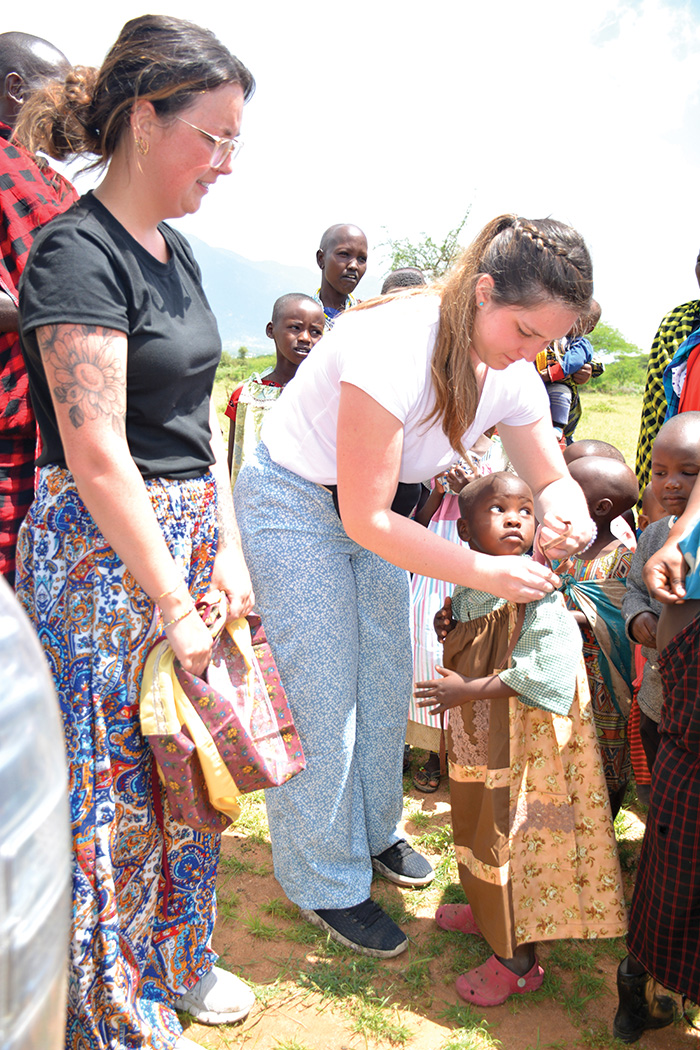

Little Dresses Group in Wawota has been helping for 10 years
Susan Eisler and Shirley Palendat of Wawota are part of Wawota’s Little Dresses Group, and are celebrating 10 years of sewing dresses for people in developing countries. There are 12 members altogether
“We started the Little Dresses group in 2014 and 20 people showed up. Now, we have made and given 10,000 dresses to people in third world countries in the last 10 years. The dresses have gone to Africa, South America, Mexico, Caribbean Island, and we’ve also sent some to the North when they have fires. We send shoeboxes at Christmas time through Samaritans Purse. Samaritans Purse runs Operation Christmas Child, which distributes shoe boxes filled with gifts and necessities from Canada to developing countries. We also make shorts. We have also made over 3,000 pairs of shorts.”
How did the group start?
“I went to a bible study and a lady asked me if there is something I would like to do that I have never done and I said I wanted to make something for African kids and she said ‘why don’t you start?’ After that, I did,” Susan said.
Shirley adds, “She was afraid nobody would show up. She put an ad in and she was afraid no one would show up, then we had over 20 people. Our first day was February 26, 2014 and we’ve met every Tuesday to sew these dresses after that.”
Susan has always wanted to sew dresses for African kids and found inspiration on the internet for designs.
“I saw something on the media somewhere of patterns for little dresses in Africa and that is why I chose to send them to Africa,” she says.
Shirley explains, “They have gone a lot of other places than Africa too, but that is the original place we had decided for them to go.”
The Little Dresses Group has had people come to them by word of mouth in the area.
“We have never ever phoned anybody saying we’ve heard of them going places and would like to take dresses. It has always been word of mouth when people take the dresses to the third world countries. They just approach us,” Susan explains.
“We know one person who goes and works in Africa and they took very many to Equatorial Guinea. It is hard to know how many people have come to us and taken dresses over the past 10 years. All I know is it has been many people and many dresses sent all over.”
“Since covid we haven’t had that many dresses go over because during covid people couldn’t travel,” Shirley says. “Afterwards, I don’t know of many people going to the poorer countries. I think around 30 people at least have come to us and taken dress to somewhere a third world country.”
Susan and Shirley explain their group has made more than just dresses for kids in developing countries.
“We’ve also made small blankets and quilts along with dresses and boys shorts. As well as pencil cases full of school supplies. During covid we made masks, headbands, and scrub caps.”
They are surprised the Little Dresses Group has lasted this long and hope to continue for as long as they can.
“I am even amazed the group has lasted 10 years. I would never have thought or in my wildest dreams thought it would last this long. I think we will just keep going,” says Shirley.
“As long as we have people donating the materials we will try to keep going, but we have lost numbers because we’ve had the odd death and some people move. So our numbers have dropped. Now, we have about 10 or 12 people coming to sew.”
They have had many donations over the years. Most materials are donated from the Grandmothers to Grandmothers Foundation based in Calgary.
“Anyone donates. At first a lot of people were cleaning out grandma’s house when they are moving and extra material that I will never use. We also have two people in Calgary that are associated with the Grandmothers to Grandmothers Foundation. They get material every spring and sell it. After the sale week we have our people in Calgary go and pick out what they want. That is where we get our material to make the dresses,” Susan said.
Shirley adds, “A lot of our material comes from Calgary. UJAMMA Grandmothers, also known as Grandmothers to Grandmothers, is a nonprofit organization that raises funds and awareness of African grandmothers who are raising orphaned children. They have the material donated to them and then they sell it and then what is left over, our two people in Calgary can go and pick what they want. We get a lot of our material from them.
“We make most of our own bias tape out of broadcloth because we couldn’t afford to make these dresses if we had to buy the bias tape. Sometimes we do have to buy material, elastics to put in the dresses, and rotary blades. However, we do get some donations from people.
“We meet every Tuesday at 1 and we stop around 3 in the afternoon for coffee and a bit of a lunch and have a good visit and it is just a good social time. The Free Methodist Church here in Wawota let us use their Cannington wing.” said Shirley.
Susan adds, “They even built us a big cupboard to put our material in.”
Susan and Shirley enjoy the social environment and the feeling they get knowing they are helping others in this world.
Susan says, “You have to do something in this world. This is ours, our little bit.
Shirley adds, ”It’s also when you are making the dresses and shorts you are associating with people you maybe wouldn’t ordinarily and it is a real good social time.”
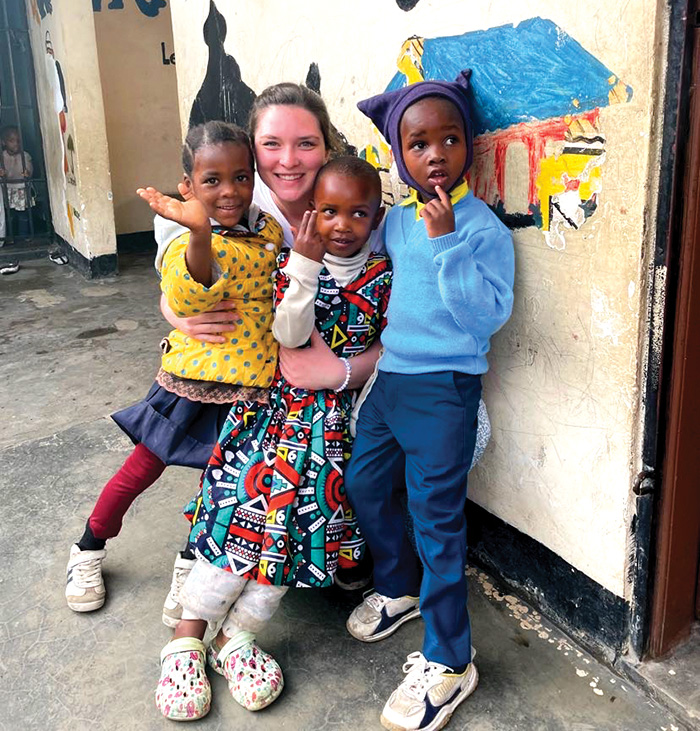
 Tweet
Tweet
